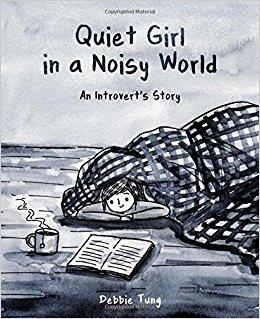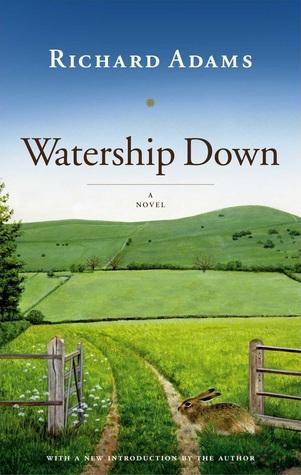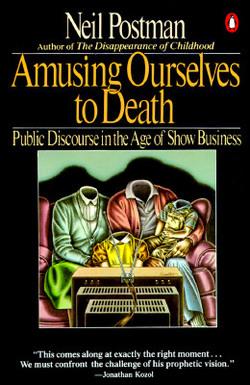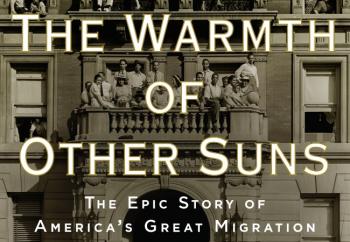
scrounge: /skrounj/ informal verb: to actively seek [books] from any available source

I found Quiet Girl in a Noisy World to be a very relatable book. There were quite a few pages here I absolutely could have written (if I had this kind of artistic talent, that is). This is the perfect book of comics for an introvert, and would especially appeal to introverts who struggle (or have struggled) with shyness and social anxiety too.
There is a loose narrative here that follows the author through finishing college, getting married, and getting (and leaving) a job, but it doesn't have to be read in chronological order to be enjoyed. I wasn't intending to rip right through this, but I found myself losing track of how much I was reading, because it's an easy read, and each vignette of introvert life made me want the next one.
I liked the "battery indicator" that showed up sometimes as a visual for how social activity can exhaust introverts. Other topics include: self-doubt and overthinking, love of books, love of solitude, and coming to terms with being who you are. And the artwork was beautiful too.
I also loved the comics that showed how she and her extroverted husband balance each other out -- it's a lovely visual about appreciating different people's strengths and weaknesses.
(Thanks to NetGalley for the review copy)
Scrounged From: NetGalley
Format: Kindle
Author/Illustrator: Debbie Tung
Pages: 184
Content Advisory: None

From Beatrix Potter to Redwall, Wind in the Willows and Jill Barklem's Brambly Hedge, among others, the British appear to be the most accomplished experts on writing fictional accounts of rodents.
Watership Down is in that category, but at 400+ pages, it's not something most children are likely to pick up. It's the story of a journey, and of survival, with plenty of heart and endearing characters.
The story follows an intrepid band of rabbits who leave their home after Fiver, an eccentric (but accurate) rabbit foretells disaster to their current warren. On the way, they encounter many obstacles and set-backs, but finally arrive at Watership Down, which they decide to make their new home. Once there, however, they realize they won't last long as a colony without females, and thus begins a new phase of adventure as they decide they must find a way to infiltrate the other warren in the area -- the one that is run under the iron paw of the ruthless General Woundwort.
While the rabbits in this story are anthropomorphized to a point, as in they do speak to each other, Richard Adams did not simply stick human personalities onto rabbits. I get the impression that he has spent an awful lot of time observing and pondering these creatures, and so the characters he created are relatable and yet feel more rabbity than human. He gives them their own folk heroes and folk tales, and you have to wonder whether rabbits really are like this if you could just speak their language.
Scrounged From: PaperbackSwap.com
Format: Paperback
Author: Richard Adams
Pages: 476
Content Advisory: Lots of peril, and several scenes of fighting and other violence, including some descriptions of injury and death.

Book Scrounger's note: The following is a guest review by Doug, a.k.a. Professor Puzzler:
In 1985, Neil Postman wrote a frightening and prophetic book called Amusing Ourselves to Death, in which he analyzed the state of public discourse in the United States. In fact, he subtitled his book, "Public Discourse in the Age of Show Business."
This book should be required reading for all students before graduating high school.
In his foreword to the book, Postman explains the difference between Aldous Huxley's Brave New World and George Orwell's 1984 and then he writes, "What Orwell feared were those who would ban books. What Huxley feared was that there would be no reason to ban a book, for there would be no one who wanted to read one..." and "This book is about the possibility that Huxley, not Orwell, was right."
From there Neil Postman goes on to argue persuasively that we are becoming a society which would rather be entertained than informed, and that more and more the media will pander to our desire for entertainment, until we reach the point that all conversation is "sound bite conversation."
To me, the most extraordinary thing about this book is that Postman wrote it when the internet was in its infancy, and the concept of "social media" hadn't even entered anyone's minds. And yet, everything Postman wrote about in 1985 describes perfectly where we are as a society in 2016. Nobody wants to think deep thoughts or read in-depth analysis of anything. The basic premise of our society is: "If it can't be expressed as a facebook meme," it's not worth considering.
Postman, on the other hand, would probably have argued, "If it can be expressed as a facebook meme, it has been robbed of any surrounding context and is therefore good purely for entertainment." And even though Postman could not have predicted social media, he predicted the effect it is having on our society: it has become the cornerstone of our hunger for entertainment over understanding.
And it's not just reading, it's also listening. Postman writes about the Lincoln-Douglas debates, in which presidential candidates debated policy for three hours straight, took a one-hour break for supper, and then continued three more hours. And the hall was packed with spectators. Imagine that! People thought it was worth their time to sit and listen to people argue policy for six hours in one day! Today, debates have become circuses in which we're more interested in watching a trainwreck than listening to anything substantive.
It reminds me of a quote which is often (and probably incorrectly) attributed to Mark Twain: "The person who does not read has no advantage over the person who cannot read." We have become a society that can't be bothered to learn, study, read, and understand. And so we are no better than a society that can't do any of those things.
Format: Paperback
Author: Neil Postman
Pages: 163
Content Advisory: None

Book Scrounger's note: The following is a guest review by Doug, a.k.a. Professor Puzzler:
If you want to gain a better understanding of the migration of blacks from the south to the north and west during the twentieth century, while reading personal stories of those involved in the migration, I highly recommend Isabel Wilkerson's The Warmth of Other Suns.
This book can look a bit daunting for people who, when they see the word "nonfiction," expect something dry, pretentiously academic, and tedious. But this book is anything but dry; its narrative will keep your attention from start to finish. Considering the book is 538 pages long (not including acknowledgements, notes, and indices), you'll want to set aside a good block of time for it.
The book follows the lives of three migrants (and their families) from the south: Ida Mae Brandon Gladney, George Swanson Starling, and Robert Joseph Pershing Foster. Each of these people left the south for different reasons, during different decades, and for different areas of the country (Chicago, New York, and California).
Even though the stories of these three people are separated by many years, their stories are told concurrently. Thus, we read about each of the migrants' living situations in the south, then about their reasons for leaving, then their actual exodus, etc. At first glance, I thought I would have a hard time keeping the stories and people straight, because of the way the book jumps from one story to another (and because Ida Mae's husband was named George, giving us two main characters named George!), but actually there was very little confusion; the events of each subject's life were so distinctly different from the others that I had no trouble keeping track of the people involved.
In the spaces between the stories of these three migrants, Wilkerson occasionally elaborates on general conditions in the north, the south, and the west; the advancement of the Civil Rights movement, and other related subjects. She also inserts related stories from other people she interviewed, as they help support the information she provides about the broader social and political picture.
For the most part, Wilkerson is not heavy-handed in her analysis of the events; she lets the characters' stories speak for themselves. The writing style is engaging, and the events are interesting, making this a quick read (for a 500+ page history).
I have read some complaints from other reviewers that by the time she gets through the first part of the book, she begins repeating herself, and the book should have been better edited. It is true that she does occasionally repeat herself, and the sudden repetition of something you've already read can be a bit disconcerting. However, it's good to remember that when she does this, it's typically because she's referring to a "minor character" that she previously mentioned a hundred pages earlier, and she wants to make sure that we remember this person she's talking about. Perhaps there are better ways to refresh our memories than to spend a paragraph recapping what she's told us before about this person, but I considered it to be only a minor flaw in the writing.
I'd like to share one of my favorite paragraphs from the book -- a paragraph about Ida Mae Brandon Gladney:
"Many years later, people would forget about the quiet successes of everyday people like Ida Mae. In the debates to come over welfare and pathology, America would overlook people like her in its fixation with the underclass, just as a teacher can get distracted by the two or three problem children at the expense of the quiet obedient ones. Few experts trained their sights on the unseen masses of migrants like her, who worked from the moment they arrived, didn't end up on welfare, stayed married because that's what God-fearing people of their generation did whether they were happy or not, and managed to not get strung out on drugs or whiskey or a cast of nameless, no-count men."
This paragraph resonated strongly with me, because it reminds me that still today, we struggle with the same sorts of broad-sweeping generalizations; we see the very worst of a group of people, and then associate that "worst" with every member of the group, without stopping to look clearly and carefully: people who are not Christian like to look at groups like Westboro Baptist and lump all Christians with them; people who are not Muslim like to look at the worst terrorists and assume all Muslims are just like that; irresponsible, right-leaning "news" sites like to look at the worst actions perpetrated in the name of "black lives matter" and arbitrarily and illogically call the entire movement a "terrorist organization" or a "hate group."
It seems that nothing has changed.
And now I'll step down from my soapbox and say: I highly recommend reading this book, and if you have teen children who are voracious readers, and are prepared for a handful of stories of graphic violence, this book is a great educational tool. You will learn how the "Great Migration" affected the south, the north, and how it affected the lives of individual people and families along the way.
Scrounged From: Professor Puzzler's Christmas wish list
Format: Paperback
Author: Isabel Wilkerson
Pages: 622
Content Advisory: Some scenes depicting graphic violence, and several scenes demonstrating racist attitudes and actions.


